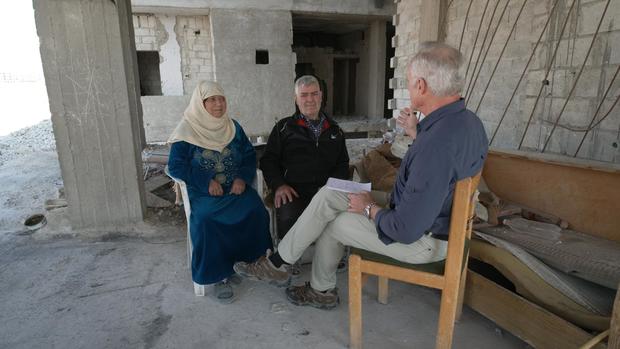In the days since former President Bashar al-Assad’s fall, Syrians have begun the anguished search for family members who vanished under the dictator’s regime.
Mohammed Saeed Zidane and his wife live in the bombed-out Ein Tarma suburb of Damascus, struggling to get by, but a new home is not what they want most. They want their 39-year-old son back; he disappeared in 2012 after being stopped at an Assad checkpoint.
His parents say they have never heard from him again. Still, they have hope for the future in Syria.
“This feels like a new birth, a new beginning,” Mohammed said. “Though my hair has turned gray and my time has passed, we feel, thank God, young again.”
Syria’s years under Assad
An entire generation of Syrians has never known freedom. Since the civil war began in 2011, an estimated 500,000 Syrians have been killed in the conflict and 13 million have been forced from their homes.
“We were living here in peace,” Zidane said. “When we just demanded freedom and to be able to earn our daily bread, the Assad regime started bombing us.”
His wife said they couldn’t hold back their tears when they saw the destruction in Ein Tarma. In one devastated building, there was no electricity or running water, no trees or fuel. The ruins run for miles in every direction.
Hafez al-Assad, Bashar al-Assad’s father, ruled Syria starting in 1970. Bashar al-Assad took over in 2000, and continued to run Syria as a brutal police state.
Throughout the civil war, 60 Minutes reported on the exodus of millions. 60 Minutes reported on the relentless bombardment of civilians and the rescue work of Syrians known as the White Helmets, civil defense volunteers who’ve given thousands a second chance at life. 60 Minutes also reported on Assad’s 2013 nerve gas and chemical attacks that killed an estimated 1,400 civilians.
By 2015, Russia and Iran had joined the war to prop up Assad’s forces. Russian airstrikes saved Assad, while hospitals in rebel territory were bombed.
60 Minute also met a generation of children orphaned by the war. Last year, Scott Pelley reported on Syrians left destitute by a massive earthquake in rebel territory.
The fall of Assad and the search for victims
Until this fall, the rebels had been cornered in the north. It appeared that Assad had won the war. But this month, his allies abandoned him. Russian President Vladimir Putin’s forces were tied up with his invasion of Ukraine. Iran was distracted by conflict with Israel. So, three weeks ago, the rebels saw an opening and swept through major cities on the way to Damascus. Assad’s army collapsed and ran away. Syrian President Bashar al Assad fled to Moscow.
The Zidane family was shocked by the fall of Assad.
“We felt like everyone else, like we were in a bad dream and finally woke up,” Mohammed said.
In examination room two of Damascus Hospital following the collapse of Assad’s regime, Dr. Ayman Nassar received 35 bodies from a notorious jail where Assad’s prisoners were tortured and executed.
“There is one with severe signs of torture,” he said. “Many of the bodies showed signs of malnutrition or lack of oxygen from overcrowding in the places where they were kept. The cause of death was most likely multiple organ failure caused by malnutrition.”
They were the last of untold thousands of Assad’s political opponents to die over the decades — people who went into his jails and vanished. When word spread of the bodies at the hospital, desperate Syrians came searching for answers.
Fayza Hussein al-Ali’s son had been among those arrested under Assad’s rule.
“There are so many like my son. From our village alone, about 70 prisoners,” she said. “We are drowning in sorrow; our hearts are burning. I am like every mother here, crushed by pain every day.”
The regime killed two of her other sons, she said. One, according to her, was killed by a sniper for no reason. The second, a parent himself, died while rescuing people during airstrikes.
Susan al-Tunji is also looking for her son. Like many, she received a death certificate from the prison years ago, but no remains.
“I pray I find him,” she said. “Even if he is dead, it’s OK, just give me the body. All I want is to find some rest.”
Forensic pathologists at the hospital compare photos and teeth. In this way, they’ve identified 18 victims so far, Dr. Nasser said.
“We empathize and do our best to help,” Dr. Nasser said. “But the pressure from the families is overwhelming.”
In the streets of Syria, parents carry photos of their children. Taghreed al-Badawi’s son disappeared 12 years ago. She calls Assad a war criminal.
Others, like Rama Al-Buka’e, carry photos of lost siblings. Rama Al-Buka’e’s brother was arrested in 2012 while on his way to a store.
“They gave us his ID card and told my mother never to ask about him again,” Al-Buka’e said. “They are a bunch of butchers.”
Mohammed Al-Shouha’s brother has been missing for 13 years. He hasn’t found his brother yet, but still hopes to.
“God willing,” Al-Shouha said.
Hopes, apprehension about the future in Syria
Hope and apprehension are filling the streets of Damascus and its 2.5 million residents. Most of the 5,000-year-old city is intact because it was Assad’s stronghold.
“We got Assad out of Syria,” one man said. “Now we must get him out of us.”
Joyful crowds headed for prayers last Friday. About 75% of Syrians are Sunni Muslims, the largest branch of Islam. The rebels are Sunni-led, and no one knows how they’ll govern.
The leader of the Syrian rebel group Hayat Tahrir al-Sham, or HTS, is 42-year-old Abu Mohammad al-Jolani, who recently reverted to using his real name, Ahmed al-Sharaa. In 2013, the U.S. named him a terrorist and, later, put a $10 million bounty on him.
So far, he has kept order. There’s little sign of destruction, looting or reprisals, and government workers are on the job. The Syrian people do not know yet how they will be governed. Peace seems to be in the hearts of many, but the violence hasn’t stopped entirely.
Israel, last week, grabbed the chance to bomb what’s left of Syria’s military, while the U.S. is hitting remnants of Islamic State terrorists in central Syria. As for Russia, recent satellite pictures of its major naval base on Syria’s Mediterranean coast now reveal that its ships are gone.
The immensity of what lies ahead is clear. It will take hundreds of billions of dollars to rebuild a destitute Syria.
“We hope, by the hands of our young people, God willing, it will be better than it was before,” Nihal al-Alawi said from her destroyed home in Ein Tarma.




